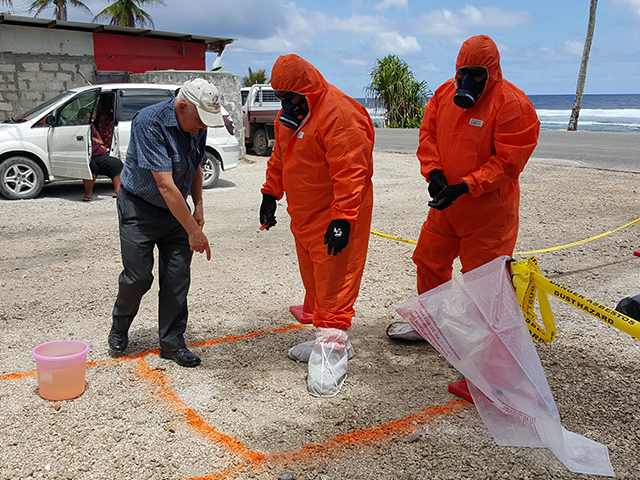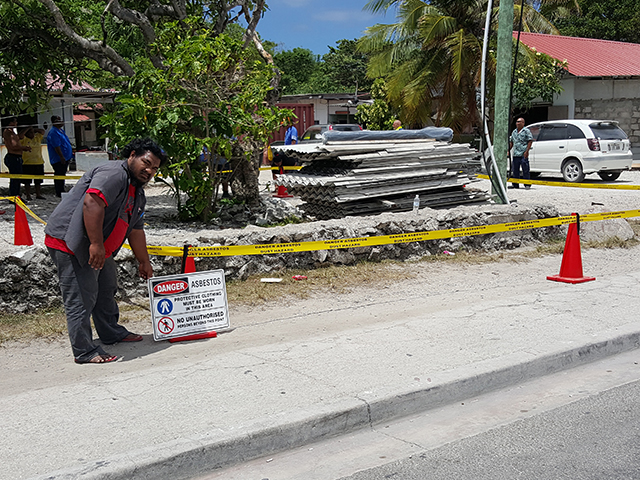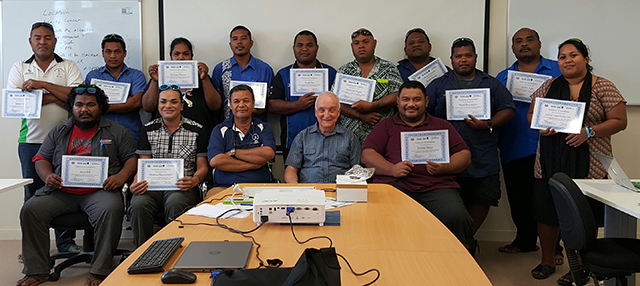
Waste Management and Pollution Control
The Government of Nauru has taken the pro-active step of arranging for the training of government employees to enforce the safe removal of asbestos across the island.
From 11 – 12 October, 12 representatives from Nauru's Department of Commerce, Industry and Environment, relevant government sectors and interested community representatives attended an intensive training programme in the safe removal, storage and handling of asbestos materials. These fully trained individuals will now be charged with the task of ensuring that Nauruan contractors undertaking asbestos removal works on the island are, at all times, adhering to international best-practice.

The training was conducted by the Pacific Hazardous Waste Management Project (PacWaste) at the request of the Government of Nauru. PacWaste is a €7.85 million project funded by the European Union and implemented by the Secretariat of the Pacific Regional Environment Programme (SPREP) to improve regional hazardous waste management across the Pacific.
Ms Mavis Depaune, Acting Secretary of the Department of Commerce, Industry and Environment in Nauru explains that addressing asbestos is a high priority for Nauru:
"The Government of Nauru is committed to taking action to address the issue of asbestos and has already commenced activities, in coordination with the government housing project, which involves the removal of asbestos from dwellings across the island. This training from PacWaste will ensure that these activities are undertaken in a manner which will ensure the health and wellbeing of workers and the people of Nauru."
The training programme included hands-on exercises such as setting up an asbestos removal zone and safely packaging asbestos roofing sheets and loose debris using the correct Personal Protective Equipment (PPE) and safe removal techniques. Following the training programme, PacWaste also assisted the department in the development of a Cabinet Paper proposing the setting up of an asbestos management regime in Nauru.

In addition to conducting the training, SPREP's PacWaste Project Manager, Mr Stewart Williams, explains that PacWaste will be directly arranging for the removal, transport and disposal of more than 4,000 square metres of asbestos materials from five locations in Nauru:
"There is a substantial quantity of asbestos in Nauru and most of it is in the form of asbestos-cement in roofing and cladding on houses and buildings. There are also some stockpiles of asbestos waste and unused asbestos material. Importantly though, these materials have significantly deteriorated with age which makes them a higher risk to human health."

SPREP's Hazardous Waste Management Advisor, Dr Frank Griffin, attended the training in Nauru to provide expert advice on the proper disposal of asbestos materials.
"Due to its significant and serious human health impacts, asbestos is considered a hazardous material and must therefore be disposed of in a manner that meets the obligations of the Basel and Noumea Conventions."
Mr Jesús Laviña, Head of Section for Natural Resources and Infrastructure at the European Union Delegation for the Pacific, Suva explains that the PacWaste activities in Nauru are just one part of a wider regional initiative:
"Across the Pacific, PacWaste is working at 73 separate sites in 11 countries to remove asbestos at some of the highest risk locations. These activities will be supported by a region-wide asbestos awareness campaign to raise public awareness of the dangers of asbestos and to highlight steps that can be taken to minimise exposure."
From 11 – 12 October, 12 representatives from Nauru's Department of Commerce, Industry and Environment, relevant government sectors and interested community representatives attended an intensive training programme in the safe removal, storage and handling of asbestos materials. These fully trained individuals will now be charged with the task of ensuring that Nauruan contractors undertaking asbestos removal works on the island are, at all times, adhering to international best-practice.

Participants from the intensive asbestos training programme in Nauru learn about best-practice decontamination practices from PacWaste consultant, Mr John O'Grady. Photo: F.Griffin/SPREP
The training was conducted by the Pacific Hazardous Waste Management Project (PacWaste) at the request of the Government of Nauru. PacWaste is a €7.85 million project funded by the European Union and implemented by the Secretariat of the Pacific Regional Environment Programme (SPREP) to improve regional hazardous waste management across the Pacific.
Ms Mavis Depaune, Acting Secretary of the Department of Commerce, Industry and Environment in Nauru explains that addressing asbestos is a high priority for Nauru:
"The Government of Nauru is committed to taking action to address the issue of asbestos and has already commenced activities, in coordination with the government housing project, which involves the removal of asbestos from dwellings across the island. This training from PacWaste will ensure that these activities are undertaken in a manner which will ensure the health and wellbeing of workers and the people of Nauru."
The training programme included hands-on exercises such as setting up an asbestos removal zone and safely packaging asbestos roofing sheets and loose debris using the correct Personal Protective Equipment (PPE) and safe removal techniques. Following the training programme, PacWaste also assisted the department in the development of a Cabinet Paper proposing the setting up of an asbestos management regime in Nauru.

Participants practice setting up a safety cordon and signage in preparation for a practice asbestos removal activity. Photo: F.Griffin/SPREP
In addition to conducting the training, SPREP's PacWaste Project Manager, Mr Stewart Williams, explains that PacWaste will be directly arranging for the removal, transport and disposal of more than 4,000 square metres of asbestos materials from five locations in Nauru:
"There is a substantial quantity of asbestos in Nauru and most of it is in the form of asbestos-cement in roofing and cladding on houses and buildings. There are also some stockpiles of asbestos waste and unused asbestos material. Importantly though, these materials have significantly deteriorated with age which makes them a higher risk to human health."

The 12 graduates from the intensive asbestos training programme in Nauru will be in charge of ensuring that all asbestos removal works are conducted using international best-practice.
SPREP's Hazardous Waste Management Advisor, Dr Frank Griffin, attended the training in Nauru to provide expert advice on the proper disposal of asbestos materials.
"Due to its significant and serious human health impacts, asbestos is considered a hazardous material and must therefore be disposed of in a manner that meets the obligations of the Basel and Noumea Conventions."
Mr Jesús Laviña, Head of Section for Natural Resources and Infrastructure at the European Union Delegation for the Pacific, Suva explains that the PacWaste activities in Nauru are just one part of a wider regional initiative:
"Across the Pacific, PacWaste is working at 73 separate sites in 11 countries to remove asbestos at some of the highest risk locations. These activities will be supported by a region-wide asbestos awareness campaign to raise public awareness of the dangers of asbestos and to highlight steps that can be taken to minimise exposure."